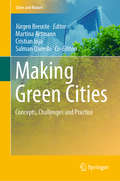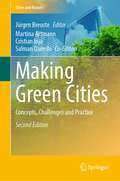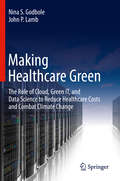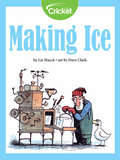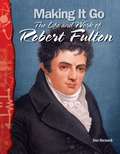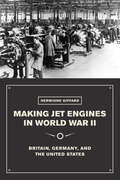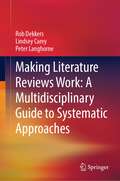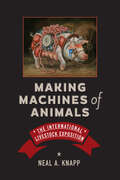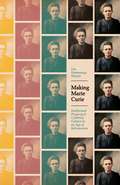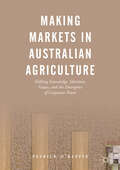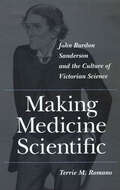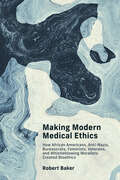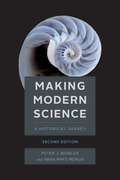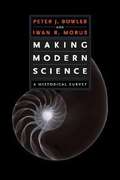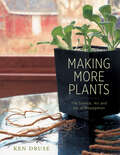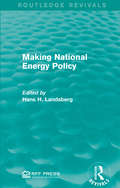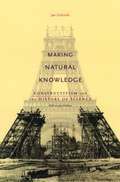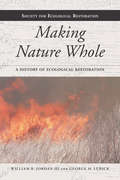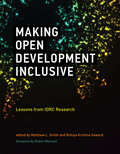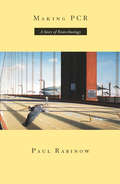- Table View
- List View
Making Green Cities: Concepts, Challenges and Practice (Cities and Nature)
by Jürgen Breuste Martina Artmann Cristian Ioja Salman QureshiThis book shows what role nature can play in a city and how this can make it a better place for people to live. People, planners, designers and politicians are working towards the development of green cities. Some cities are already promoted as green cities, while others are on their way to become one. But their goals are often unclear and can include different facets. Presenting contributions from world leading researchers in the field of urban ecology, the editors provide an interdisciplinary overview of best practices and challenges in creating green cities. They show examples of how to build up these cities from bits and pieces to districts and urban extensions. Each example concludes with a summary of the collected knowledge, the learning points and how this can be used in other places. The best practices are collected from around the world – Europe, Australia, America and Asia. The new dynamic urban development of Asia is illustrated by case studies from China and the Indian subcontinent. The reader will learn which role nature can play in green cities and what the basic requirements are in terms of culture, pre-existing nature conditions, existing urban surroundings, history, design and planning.
Making Green Cities: Concepts, Challenges and Practice (Cities and Nature)
by Jürgen Breuste Martina Artmann Cristian Ioja Salman QureshiThis book shows what role nature can play in a city and how this can make it a better place for people to live. People, planners, designers and politicians are working towards the development of green cities. Some cities are already promoted as green cities, while others are on their way to become one. But their goals are often unclear and can include different facets. Presenting contributions from world leading researchers in the field of urban ecology, the editors provide an interdisciplinary overview of best practices and challenges in creating green cities. They show examples of how to build up these cities from bits and pieces to districts and urban extensions. Each example concludes with a summary of the collected knowledge, the learning points and how this can be used in other places. The best practices are collected from around the world – Europe, America and Asia. Contributions cover a wide range of biophysical and cultural backgrounds within these three continents, including the Central, Southern and Eastern European region, as well as Latin and North America. The new dynamic urban development of Asia is illustrated by case studies from China and the Indian subcontinent. The reader will learn which role nature can play in green cities and what the basic requirements are in terms of culture, pre-existing nature conditions, existing urban surroundings, history, design and planning.
Making Healthcare Green: The Role of Cloud, Green IT, and Data Science to Reduce Healthcare Costs and Combat Climate Change
by Nina S. Godbole John P. LambThis book offers examples of how data science, big data, analytics, and cloud technology can be used in healthcare to significantly improve a hospital’s IT Energy Efficiency along with information on the best ways to improve energy efficiency for healthcare in a cost effective manner. The book builds on the work done in other sectors (mainly data centers) in effectively measuring and improving IT energy efficiency and includes case studies illustrating power and cooling requirements within Green Healthcare.Making Healthcare Green will appeal to professionals and researchers working in the areas of analytics and energy efficiency within the healthcare fields.
Making Healthy Places
by Richard J. Jackson Andrew L. Dannenberg Howard FrumkinThis book provides a far-reaching follow-up to the pathbreaking Urban Sprawl and Public Health, published by Island Press in 2004. That book sparked a range of inquiries into the connections between constructed environments, particularly cities and suburbs, and human health. Since then, numerous studies have extended and refined the book's research and reporting. Making Healthy Places offers a fresh and comprehensive look at this vital subject today, from the scale of buildings up to the scale of metropolitan areas. There is no other book with the depth, breadth, vision and accessibility that this book offers. Like a well-trained doctor, it presents a diagnosis of-and offers treatment for-problems related to the built environment. Drawing on the latest scientific evidence, with contributions from experts in a range of fields, it imparts a wealth of practical information, emphasizing demonstrated and promising solutions to common problems. Health professionals, planners, architects, developers, elected officials, students, and concerned members of the public will find this book invaluable.
Making India Disaster Resilient: Challenges and Future Perspectives
by Chandrakanta Vishwa Raj SharmaVarious natural and man-made hazards are nowadays increasingly considered as disasters, particularly by individual and communities are lacking in awareness and where a system as a whole has no adequate management mechanism. Consequently, the world is facing serious negative outcome in form of loss of life, injury, disability, loss of property, infrastructure, and economic disruption followed by psycho-social disorders. Other than this, disasters adversely affect wildlife and environment in long terms. Developing countries are worst sufferers as these regions are poorly prepared for potential hazards at one hand and are exposed to disasters due to the complexity of (socio-cultural, economic and physical) vulnerability. Government, World communities, NGOs are recognizing the problems and are trying to build resilient communities to reduce disaster impact at various levels.Year 1990-99 was observed as the decade for natural disaster reduction by United Nations (UN) and United Nations International Strategy for Disaster Reduction (UNISDR) was established to support and coordinate this movement. Year 2015 has been very important in the history as three global agreements have been signed by global communities (Sustainable development goals, Paris agreement and Sendai framework for DRR). Where, SDGs are extension of MDGs to make the planet more sustainable. It proposed 17 goals and 15 years’ time frame adopted in the year 2015. SDGs target various social, cultural, economic, challenges followed by wildlife, environmental protection through knowledge share and technological innovation among all member countries. In December 2015, UNFCCC reached a landmark agreement to combat climate change and to accelerate and intensify the actions and investments needed for a sustainable low carbon future known as Paris agreement. Sendai Framework 2015 is voluntary, non-binding agreement which recognizes that the state has the primary role to reduce disasterrisk but that responsibility should be shared with other stakeholders including local government, the private sector and other stakeholders. This framework focuses on the pre-disaster management rather than post disaster relief and recovery. This book is an insight into the various issues related to the emerging disasters (both natural and man-made), vulnerable communities, and government initiatives taken with a geographical focus on India. This volume contains selected chapters written by faculty and research scholars. This book is an empirical work on disasters vulnerabilities and management which will benefit researchers, academicians, professional, practitioners and policy makers.
Making It Go: The Life And Work Of Robert Fulton
by Don HerweckRobert Fulton is best known for inventing the first successful steamboat, but that is just one of his many accomplishments. Fulton was an inventor, artist, statesman, mechanic, and engineer who used his artistic skills to sketch his inventions, which he also built. He even designed what would become the submarine.
Making Jet Engines in World War II: Britain, Germany, and the United States
by Hermione GiffardOur stories of industrial innovation tend to focus on individual initiative and breakthroughs. With Making Jet Engines in World War II, Hermione Giffard uses the case of the development of jet engines to offer a different way of understanding technological innovation, revealing the complicated mix of factors that go into any decision to pursue an innovative, and therefore risky technology. Giffard compares the approaches of Britain, Germany, and the United States. Each approached jet engines in different ways because of its own war aims and industrial expertise. Germany, which produced more jet engines than the others, did so largely as replacements for more expensive piston engines. Britain, on the other hand, produced relatively few engines--but, by shifting emphasis to design rather than production, found itself at war's end holding an unrivaled range of designs. The US emphasis on development, meanwhile, built an institutional basis for postwar production. Taken together, Giffard's work makes a powerful case for a more nuanced understanding of technological innovation, one that takes into account the influence of the many organizational factors that play a part in the journey from idea to finished product.
Making Literature Reviews Work: A Multidisciplinary Guide to Systematic Approaches
by Peter Langhorne Rob Dekkers Lindsey CareyThis textbook guides the reader on how to undertake high-quality literature reviews, from traditional narrative to protocol-driven reviews. The guidance covers a broad range of purposes, disciplines and research paradigms. Whether the literature review is part of a research project, doctoral study, dissertation or a stand-alone study, the book offers approaches, methods, tools, tips and guidelines to produce more effective literature reviews in an efficient manner. The numerous examples are drawn from an array of subject areas, such as economics, healthcare, education, medicine, psychology, software engineering amongst others. This makes it worthwhile for a wide range of studies and for reviews into evidence-based interventions, policies, practices and treatments. There is attention given to presenting, reporting and publishing literature reviews. With the additional clarity brought about by explanatory tables and graphs, this textbook is a ‘must-have’ for all students, researchers, academics and practitioners at any stage of their project or career when engaging with literature. In addition, citizens, policymakers and practitioners will benefit from the guidance with better insight into how literature reviews could and should have been conducted.
Making Machines of Animals: The International Livestock Exposition (Animals, History, Culture)
by Neal A. KnappHow the Chicago International Livestock Exposition leveraged the eugenics movement to transform animals into machines and industrialize American agriculture.In 1900, the Chicago International Livestock Exposition became the epicenter of agricultural reform that focused on reinventing animals' bodies to fit a modern, industrial design. Chicago meatpackers partnered with land-grant university professors to create the International—a spectacle on the scale of a world's fair—with the intention of setting the standard for animal quality and, in doing so, transformed American agriculture.In Making Machines of Animals, Neal A. Knapp explains the motivations of both the meatpackers and the professors, describing how they deployed the International to redefine animality itself. Both professors and packers hoped to replace so-called scrub livestock with "improved" animals and created a new taxonomy of animal quality based on the burgeoning eugenics movement. The International created novel definitions of animal superiority and codified new norms, resulting in a dramatic shift in animal weight, body size, and market age. These changes transformed the animals from multipurpose to single-purpose products. These standardized animals and their dependence on off-the-farm inputs and exchanges limited farmer choices regarding husbandry and marketing, ultimately undermining any goals for balanced farming or the maintenance and regeneration of soil fertility.Drawing on land-grant university research and publications, meatpacker records and propaganda, and newspaper and agricultural journal articles, Knapp critiques the supposed market-oriented, efficiency-driven industrial reforms proffered by the International, which were underpinned by irrational, racist ideologies. The livestock reform movement not only resulted in cruel and violent outcomes for animals but also led to twentieth-century crops and animal husbandry that were rife with inefficiencies and agricultural vulnerabilities.
Making Makers: Kids, Tools, and the Future of Innovation
by AnnMarie ThomasThis is a book for parents and other educators—both formal and informal, who are curious about the intersections of learning and making. Through stories, research, and data, it builds the case for why it is crucial to encourage today’s youth to be makers—to see the world as something they are actively helping to create. For those who are new to the Maker Movement, some history and introduction is given as well as practical advice for getting kids started in making. For those who are already familiar with the Maker Movement, this book provides biographical information about many of the “big names” and unsung heroes of the Maker Movement while also highlighting many of the attributes that make this a movement that so many people are passionate about.
Making Marie Curie: Intellectual Property and Celebrity Culture in an Age of Information
by Eva Hemmungs WirténIn many ways, Marie Curie represents modern science. Her considerable lifetime achievements--the first woman to be awarded a Nobel Prize, the only woman to be awarded the Prize in two fields, and the only person to be awarded Nobel Prizes in multiple sciences--are studied by schoolchildren across the world. When, in 2009, the New Scientist carried out a poll for the "Most Inspirational Female Scientist of All Time," the result was a foregone conclusion: Marie Curie trounced her closest runner-up, Rosalind Franklin, winning double the number of Franklin's votes. She is a role model to women embarking on a career in science, the pride of two nations--Poland and France--and, not least of all, a European Union brand for excellence in science. Making Marie Curie explores what went into the creation of this icon of science. It is not a traditional biography, or one that attempts to uncover the "real" Marie Curie. Rather, Eva Hemmungs Wirtén, by tracing a career that spans two centuries and a world war, provides an innovative and historically grounded account of how modern science emerges in tandem with celebrity culture under the influence of intellectual property in a dawning age of information. She explores the emergence of the Curie persona, the information culture of the period that shaped its development, and the strategies Curie used to manage and exploit her intellectual property. How did one create and maintain for oneself the persona of scientist at the beginning of the twentieth century? What special conditions bore upon scientific women, and on married women in particular? How was French identity claimed, established, and subverted? How, and with what consequences, was a scientific reputation secured? In its exploration of these questions and many more, Making Marie Curie provides a composite picture not only of the making of Marie Curie, but the making of modern science itself.
Making Markets in Australian Agriculture: Shifting Knowledge, Identities, Values, and the Emergence of Corporate Power
by Patrick O'KeeffeThis book provides a genealogical study of Australian agricultural restructuring, focusing on the case study of wheat export market deregulation. This policy shift was implemented in 2008, ending 60 years of statutory wheat marketing. At the time, policy makers claimed that market liberalisation would empower individual growers, providing them with choice and freedom through uninhibited participation in markets. However, regional wheat markets have become concentrated, and are increasingly controlled by a small number of transnational agribusiness firms, which have been increasingly active in setting the policy agenda in Australian agriculture. The book delves into the discursive construction of policy truths such as efficiency, competition, and the consumer, to understand how this shift was made possible, whose interests have been served, and what the implications of this shift have been. This book focuses on the machinations which contributed to this shift by examining the construction of knowledge, values and identities, which have helped to make the transition from the public to the private appear as a logical, common sense solution to the challenges facing Australian agriculture. The author shows how governmental technologies such as audit, cost-benefit analysis, performance objectives and the consumer were used to make this reality operable. In doing so, he argues that this shift should be viewed as part of the broader restructuring of Australian society, which has facilitated the transference of economic and policy making power from the public to the private.
Making Medicine Scientific: John Burdon Sanderson and the Culture of Victorian Science
by Terrie M. RomanoIn Victorian Britain scientific medicine encompassed an array of activities, from laboratory research and the use of medical technologies through the implementation of sanitary measures that drained canals and prevented the adulteration of milk and bread. Although most practitioners supported scientific medicine, controversies arose over where decisions should be made, in the laboratory or in the clinic, and by whom—medical practitioners or research scientists. In this study, Terrie Romano uses the life and eclectic career of Sir John Burdon Sanderson (1829-1905) to explore the Victorian campaign to make medicine scientific.Sanderson, in many ways a prototypical Victorian, began his professional work as a medical practitioner and Medical Officer of Health in London, then became a pathologist and physiologist and eventually the Regius Professor of Medicine at Oxford. His career illustrates the widespread support during this era for a medicine based on science. In Making Medicine Scientific, Romano argues this support was fueled by the optimism characteristic of the Victorian age, when the application of scientific methods to a range of social problems was expected to achieve progress. Dirt and disease as well as the material culture of experimentation —from frogs to photographs—represent the tangible context in which Sanderson lived and worked. Romano's detailed portrayal reveals a fascinating figure who embodied the untidy nature of the Victorian age's shift from an intellectual system rooted in religion to one based on science.
Making Medicine Scientific: John Burdon Sanderson and the Culture of Victorian Science
by Terrie M. RomanoA biography of the English physician and scientist and a history of the advancement of science in the Victorian era.In Victorian Britain, scientific medicine encompassed an array of activities, from laboratory research and the use of medical technologies through the implementation of sanitary measures that drained canals and prevented the adulteration of milk and bread. Although most practitioners supported scientific medicine, controversies arose over where decisions should be made, in the laboratory or in the clinic, and by whom—medical practitioners or research scientists. In this study, Terrie Romano uses the life and eclectic career of Sir John Burdon Sanderson (1829-1905) to explore the Victorian campaign to make medicine scientific.Sanderson, a prototypical Victorian, began his professional work as a medical practitioner and Medical Officer of Health in London, then became a pathologist and physiologist and eventually the Regius Professor of Medicine at Oxford. His career illustrates the widespread support during this era for a medicine based on science. In Making Medicine Scientific, Romano argues this support was fueled by the optimism characteristic of the Victorian age, when the application of scientific methods to a range of social problems was expected to achieve progress. Dirt and disease as well as the material culture of experimentation —from frogs to photographs—represent the tangible context in which Sanderson lived and worked. Romano’s detailed portrayal reveals a fascinating figure who embodied the untidy nature of the Victorian age’s shift from an intellectual system rooted in religion to one based on science.“A useful entry in the canon of science and public health . . . an antidote to the hubris of recent claims of accomplishment.” —Choice
Making Modern Medical Ethics: How African Americans, Anti-Nazis, Bureaucrats, Feminists, Veterans, and Whistleblowing Moralists Created Bioethics (Basic Bioethics)
by Robert BakerThe little-known stories of the people responsible for what we know today as modern medical ethics.In Making Modern Medical Ethics, Robert Baker tells the counter history of the birth of bioethics, bringing to the fore the stories of the dissenters and whistleblowers who challenged the establishment. Drawing on his earlier work on moral revolutions and the history of medical ethics, Robert Baker traces the history of modern medical ethics and its bioethical turn to the moral insurrections incited by the many unsung dissenters and whistleblowers: African American civil rights leaders, Jewish Americans harboring Holocaust memories, feminists, women, and Anglo-American physicians and healthcare professionals who were veterans of the World Wars, the Cold War, and the Vietnam War.The standard narrative for bioethics typically emphasizes the morally disruptive medical technologies of the latter part of the twentieth century, such as the dialysis machine, the electroencephalograph, and the ventilator, as they created the need to reconsider traditional notions of medical ethics. Baker, however, tells a fresh narrative, one that has historically been neglected (e.g., the story of the medical veterans who founded an international medical organization to rescue medicine and biomedical research from the scandal of Nazi medicine), and also reveals the penalties that moral change agents paid (e.g., the stubborn bureaucrat who was demoted for her insistence on requiring and enforcing research subjects&’ informed consent). Analyzing major statements of modern medical ethics from the 1946–1947 Nuremberg Doctors Trials and Nuremberg Code to A Patient&’s Bill of Rights, Making Modern Medical Ethics is a winning history of just how respect and autonomy for patients and research subjects came to be codified.
Making Modern Science, Second Edition: A Historical Survey
by Peter J. Bowler Iwan Rhys MorusIn this new edition of the top-selling coursebook, seasoned historians Peter J. Bowler and Iwan Rhys Morus expand on their authoritative survey of how the development of science has shaped our world. Exploring both the history of science and its influence on modern thought, the authors chronicle the major developments in scientific thinking, from the revolutionary ideas of the seventeenth century to contemporary issues in genetics, physics, and more. Thoroughly revised and expanded, the second edition draws on the latest research and scholarship. It also contains two entirely new chapters: one that explores the impact of computing on the development of science, and another that shows how the West used science and technology as tools for geopolitical expansion. Designed for entry-level college courses and as a single-volume introduction for the general reader, Making Modern Science presents the history of science not as a series of names and dates, but as an interconnected and complex web of relationships joining science and society.
Making Modern Science, Second Edition: A Historical Survey
by Peter J. Bowler Iwan Rhys MorusIn this new edition of the top-selling coursebook, seasoned historians Peter J. Bowler and Iwan Rhys Morus expand on their authoritative survey of how the development of science has shaped our world. Exploring both the history of science and its influence on modern thought, the authors chronicle the major developments in scientific thinking, from the revolutionary ideas of the seventeenth century to contemporary issues in genetics, physics, and more. Thoroughly revised and expanded, the second edition draws on the latest research and scholarship. It also contains two entirely new chapters: one that explores the impact of computing on the development of science, and another that shows how the West used science and technology as tools for geopolitical expansion. Designed for entry-level college courses and as a single-volume introduction for the general reader, Making Modern Science presents the history of science not as a series of names and dates, but as an interconnected and complex web of relationships joining science and society.
Making Modern Science: A Historical Survey
by Peter J. Bowler Iwan R. MorusA textbook about the history of modern science with cross-references. The book is divided into two parts, one on episodes, the other on themes. It covers all major developments in scientific thinking--evolutionism, genetics, nuclear physics, and modern cosmology.
Making More Plants: The Science, Art, and Joy of Propagation
by Ken DruseA guide to propagation from the author of The New Shade Garden, with over 500 photographs: “My bible for rejuvenating plants.” —Anne Raver, The New York TimesFor people who love gardens, propagation—the practice of growing whatever you want, whenever you want—is gardening itself. In Making More Plants, one of America's foremost gardening authorities, presents innovative, practical techniques for expanding any plant collection, along with more than 500 photographs. Based on years of research, this is a practical manual as well as a beautiful garden book, presenting procedures Ken Druse has personally tested and adapted, as well as photographed step by step.“This is a book for all seasons, and will appeal to anyone intrigued by how plants grow.” —Virginia McClain Miller, Fine Gardening
Making National Energy Policy (Routledge Revivals)
by Hans H. LandsbergWhat we call the nation’s energy policy attempts to give direction to the production, use, transportation, and distribution of energy to help achieve an array of societal goals in the most compatible ways. In this title, originally published in 1993, noted analysts provide insight into complex policy issues of significant importance. Among the topics addressed are difficulties encountered in trying to fashion energy policy in the U.S. congress, the nature of energy policies and environmental polices, the challenges arising from regional conflict over energy policies, and the viability of deregulating electric power production. This collection of lectures is a valuable resource for students interested in environmental studies and public policy.
Making Natural Knowledge: Constructivism and the History of Science
by Jan GolinskiArguably the best available introduction to constructivism, a research paradigm that has dominated the history of science for the past forty years, Making Natural Knowledge reflects on the importance of this theory, tells the history of its rise to prominence, and traces its most important tensions. Viewing scientific knowledge as a product of human culture, Jan Golinski challenges the traditional trajectory of the history of science as steady and autonomous progress. In exploring topics such as the social identity of the scientist, the significance of places where science is practiced, and the roles played by language, instruments, and images, Making Natural Knowledge sheds new light on the relations between science and other cultural domains. "A standard introduction to historically minded scholars interested in the constructivist programme. In fact, it has been called the 'constructivist's bible' in many a conference corridor."—Matthew Eddy, British Journal for the History of Science
Making Nature Whole: A History of Ecological Restoration (Science Practice Ecological Restoration)
by William R. Jordan III George M. LubickMaking Nature Whole is a seminal volume that presents an in-depth history of the field of ecological restoration as it has developed in the United States over the last three decades. The authors draw from both published and unpublished sources, including archival materials and oral histories from early practitioners, to explore the development of the field and its importance to environmental management as well as to the larger environmental movement and our understanding of the world. Making Nature Whole is a landmark contribution, providing context and history regarding a distinctive form of land management and giving readers a fascinating overview of the development of the field. It is essential reading for anyone interested in understanding where ecological restoration came from or where it might be going.
Making Open Development Inclusive: Lessons from IDRC Research (International Development Research Centre)
by Matthew L. Smith and Ruhiya Kristine SewardDrawing on ten years of empirical work and research, analyses of how open development has played out in practice.A decade ago, a significant trend toward openness emerged in international development. "Open development" can describe initiatives as disparate as open government, open health data, open science, open education, and open innovation. The theory was that open systems related to data, science, and innovation would enable more inclusive processes of human development. This volume, drawing on ten years of empirical work and research, analyzes how open development has played out in practice.
Making PCR: A Story of Biotechnology
by Paul RabinowMaking PCR is the fascinating, behind-the-scenes account of the invention of one of the most significant biotech discoveries in our time—the polymerase chain reaction. Transforming the practice and potential of molecular biology, PCR extends scientists' ability to identify and manipulate genetic materials and accurately reproduces millions of copies of a given segment in a short period of time. It makes abundant what was once scarce—the genetic material required for experimentation.Making PCR explores the culture of biotechnology as it emerged at Certus Corporation during the 1980s and focuses on its distinctive configuration of scientific, technical, social, economic, political, and legal elements, each of which had its own separate trajectory over the preceding decade. The book contains interviews with the remarkable cast of characters who made PCR, including Kary Mullin, the maverick who received the Nobel prize for "discovering" it, as well as the team of young scientists and the company's business leaders. This book shows how a contingently assembled practice emerged, composed of distinctive subjects, the site where they worked, and the object they invented. "Paul Rabinow paints a . . . picture of the process of discovery in Making PCR: A Story of Biotechnology [and] teases out every possible detail. . . . Makes for an intriguing read that raises many questions about our understanding of the twisting process of discovery itself."—David Bradley, New Scientist "Rabinow's book belongs to a burgeoning genre: ethnographic studies of what scientists actually do in the lab. . . . A bold move."—Daniel Zalewski, Lingua Franca "[Making PCR is] exotic territory, biomedical research, explored. . . . Rabinow describes a dance: the immigration and repatriation of scientists to and from the academic and business worlds."—Nancy Maull, New York Times Book Review
